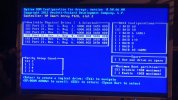Hello!
I bought a HP Proliant DL380e G8 server with 2xE5-2450L and 64GB of RAM. I have 4 x WD Red WD40EFAX 4TB HDDs and 2 x ADATA 240GB 2,5" SATA Ultimate SU630 SSDs. The server RAID battery has been refurbished.
Here are the RAID controllers on this machine:
The goal of the server is to be a homelab and a NAS: it will run mainly nextcloud and openmediavault (with multiple docker containers, e.g. reverse proxy, dns sinkhole and game servers like Factorio, Valheim or Minecraft).
Currently I installed Proxmox on those 2 SSDs, which are configured as RAID-1, the 4TB disks are waiting in line.
My idea was to utilize the SSDs for stuff that needs fast access and HDDs for media, backups etc.
For those 4TB HDDs - should I go with hardware RAID + LVM or straight with ZFS? I value being hardware- and vendor-independent, so I'm leaning towards ZFS. However (AFAIK) the LEDs on my machine won't serve their purpose then and I don't know how much will the performance go down...
What would be the best recommendation to configure the disks?
I bought a HP Proliant DL380e G8 server with 2xE5-2450L and 64GB of RAM. I have 4 x WD Red WD40EFAX 4TB HDDs and 2 x ADATA 240GB 2,5" SATA Ultimate SU630 SSDs. The server RAID battery has been refurbished.
Here are the RAID controllers on this machine:
Code:
[12:08:36][root@zoltan]:~# lspci -knn | grep -A 1 'RAID bus controller'
00:1f.2 RAID bus controller [0104]: Intel Corporation C600/X79 series chipset SATA RAID Controller [8086:1d04] (rev 05)
Subsystem: Hewlett Packard Enterprise C600/X79 series chipset SATA RAID Controller [1590:0048]
--
0a:00.0 RAID bus controller [0104]: Hewlett-Packard Company Smart Array Gen8 Controllers [103c:323b] (rev 01)
Subsystem: Hewlett-Packard Company P420 [103c:3351]The goal of the server is to be a homelab and a NAS: it will run mainly nextcloud and openmediavault (with multiple docker containers, e.g. reverse proxy, dns sinkhole and game servers like Factorio, Valheim or Minecraft).
Currently I installed Proxmox on those 2 SSDs, which are configured as RAID-1, the 4TB disks are waiting in line.
My idea was to utilize the SSDs for stuff that needs fast access and HDDs for media, backups etc.
For those 4TB HDDs - should I go with hardware RAID + LVM or straight with ZFS? I value being hardware- and vendor-independent, so I'm leaning towards ZFS. However (AFAIK) the LEDs on my machine won't serve their purpose then and I don't know how much will the performance go down...
What would be the best recommendation to configure the disks?


